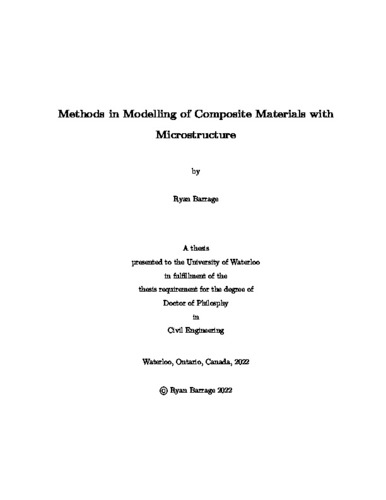| dc.contributor.author | Barrage, Ryan | |
| dc.date.accessioned | 2022-08-12 13:00:36 (GMT) | |
| dc.date.available | 2022-08-12 13:00:36 (GMT) | |
| dc.date.issued | 2022-08-12 | |
| dc.date.submitted | 2022-08-10 | |
| dc.identifier.uri | http://hdl.handle.net/10012/18539 | |
| dc.description.abstract | Composite material properties are dependent on their microstructure. To adequately model these materials, a revised formulation of elasticity that accounts for microstructural effects must be considered. Size dependent behaviour is an inherent property of such materials, resulting in a need for non-classical continuum theories for adequate characterization.
The modelling of bi-material composites is investigated, with emphasis on how material microstructure impacts the overall behaviour of continua. The work aims to provide mathematical models capable of predicting the homogenized material response under specified loads given known constituent properties, for eventual use in creating design provisions, integration into numerical simulations, and further applications in materials research. Specifically, this thesis considers Cosserat (micropolar) elasticity to model microstructural effects.
Fiber reinforced composites with unidirectional fibers are modelled as transversely isotropic materials under the framework of Cosserat elasticity. The model assumes a periodic microstructure and develops a boundary condition to account for the periodicity. The governing equations for plane strain are developed, with the conditions for existence and uniqueness of the solution established.
A three-dimensional model for an exponentially graded composite with microstructural effects is developed under the framework of Cosserat elasticity. The mixed boundary value problem is formulated and existence and uniqueness of a weak solution is established for use in accordance with the finite element method. The finite element formulation is developed and integrated into the commercial software Abaqus through a user developed element, with an associated post processing code for output visualization. Given a lack of elastic constants from experiments, validation is partially obtained through recovery of the classical limit. Following this, a conceptual extension to demonstrate a proof of concept is applied, with conclusions drawn based on the results. Recommendations for future extensions of the model are provided. | en |
| dc.language.iso | en | en |
| dc.publisher | University of Waterloo | en |
| dc.subject | functionally graded | en |
| dc.subject | Cosserat elasticity | en |
| dc.subject | composite material | en |
| dc.subject | finite element analysis | en |
| dc.title | Methods in Modelling of Composite Materials with Microstructure | en |
| dc.type | Doctoral Thesis | en |
| dc.pending | false | |
| uws-etd.degree.department | Civil and Environmental Engineering | en |
| uws-etd.degree.discipline | Civil Engineering | en |
| uws-etd.degree.grantor | University of Waterloo | en |
| uws-etd.degree | Doctor of Philosophy | en |
| uws-etd.embargo.terms | 0 | en |
| uws.contributor.advisor | Potapenko, Stanislav | |
| uws.contributor.advisor | Polak, Marianna | |
| uws.contributor.affiliation1 | Faculty of Engineering | en |
| uws.published.city | Waterloo | en |
| uws.published.country | Canada | en |
| uws.published.province | Ontario | en |
| uws.typeOfResource | Text | en |
| uws.peerReviewStatus | Unreviewed | en |
| uws.scholarLevel | Graduate | en |

